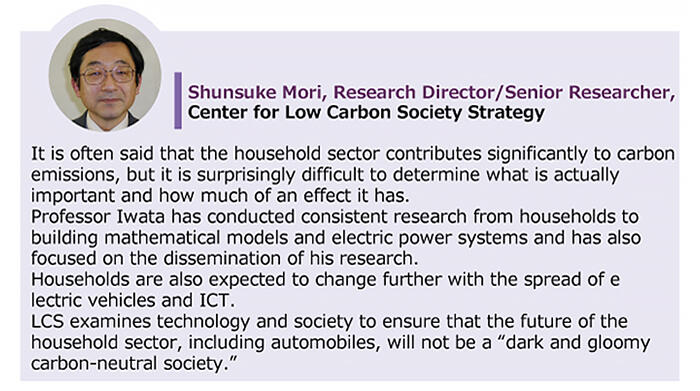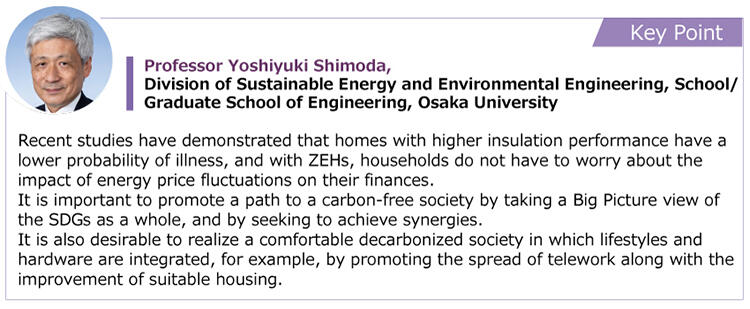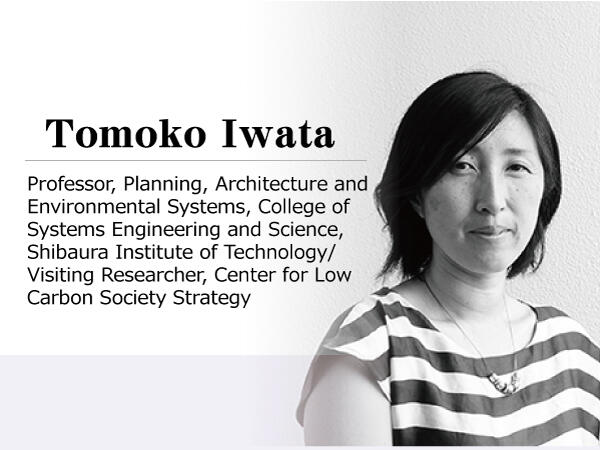
This is the second installment of a series of articles on the proposals published by the Center for Low Carbon Society Strategy (LCS) featuring a young trading company employee, Yutaka Minagawa, as the main character in the story. Having last interviewed LCS Director-General Hiroshi Komiyama about "revitalizing Japan starting with decarbonization," Yutaka Minagawa has embarked on a full-scale study to incorporate decarbonization into his company's core business. In this instalment, he asked Tomoko Iwata , a visiting researcher at LCS, who is involved in the development of a medium- to long-term energy consumption assessment model for the consumer sector, about what individuals can do to contribute to decarbonization.
CO2 is emitted in all activities ― The newer the appliance, the higher its efficiency
Minagawa: Today, I would like to talk about decarbonization at the individual and household level. Where exactly do carbon dioxide (CO2) emissions come from in our daily lives?
Iwata: They come from all sorts of consumption activities, including food, clothing, housing, services and transportation. Even durable consumer goods such as clothing and homes emit CO2 from their production, all the way to their disposal.
Minagawa: I see. Ah, but because vegetables, grains, and other agricultural products photosynthesize, don't they absorb CO2?
Iwata: You are very perceptive. Indeed, agricultural products do absorb CO2 during the growth process after they are planted. But once they are harvested, CO2 is emitted in exhaled breath in the process of them being eaten and consumed as an energy source by everyone, so the emissions from this alone are plus or minus zero. On top of that, energy is also used in their distribution and sales, and you cannot ignore the fact that CO2 is emitted in the production of chemical fertilizers. There are also a lot of emissions from heating in greenhouse farming.
Minagawa: Even so, we can't tell people to eat less to reduce CO2 emissions.
Iwata: That's right. But through a little ingenuity, there are some items that can greatly reduce CO2 emissions. What do you think emits the most CO2 in your household?
Minagawa: Some people don't have cars, so maybe utilities?
Iwata: Correct! Emissions are particularly high in heat-related applications and in applications with long usage times. Heating and hot water heating, which have the largest absolute heat outputs, have the greatest impacts. Increasing home insulation and using a heat pump to heat water are effective in countering this.
Minagawa: I see. Is there an easier way to deal with this?
Iwata: Although not as effective as air conditioning or a hot water heater, what about your choice of refrigerator, for example? When replacing it, I recommend choosing a slightly larger size. If you pack a small refrigerator full of food, the cooling efficiency will not be as good as it could be. Besides, the larger the volume, the smaller the surface area for the capacity. So, the insulation efficiency is very good.
Minagawa: It's the same logic behind why bears, tigers, and other animals that live in the north are larger as species!
Iwata: This is Bergmann's rule. It's also true with air conditioners; newer models are more efficient, so if you are using an older appliance that is more than 10 years old, replacing it with a newer model is better for the environment and the family budget.
Minagawa: Are you trying to upsell me an appliance?
Iwata: No, of course not! Take a look at the data I have prepared (Fig. 1).
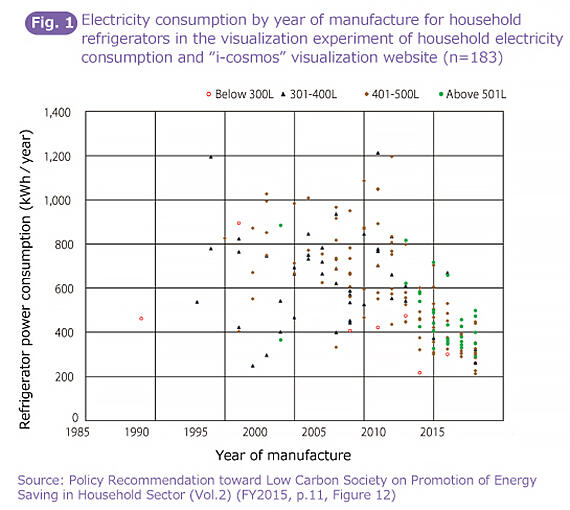
Minagawa: The newer the refrigerator, the more efficient it is, and the power consumption of a large capacity refrigerator is the same as that of a small one, so it is definitely better than an old, small refrigerator. However, many people may feel hesitant to make energy-saving investments such as replacing large appliances. These kinds of actions cost money after all.
Iwata: We are also researching ways to get the word out based on the "Nudge" concept, which is often used in behavioral economics and other fields. Have you ever lined up in an orderly manner even though you are not forced to do so just because there are footprint marks on the floor, or conversely, have you ever been told to "do your homework!" and then lose all desire to do so?
Minagawa: I sure have.
Iwata: By leveraging the habits of human thinking, we can encourage action without forcing it. The cooperation of researchers in the humanities and social sciences, such as behavioural economics, is essential for this research. Specifically, consider the straightforward advice shown in the figure (Fig. 2).
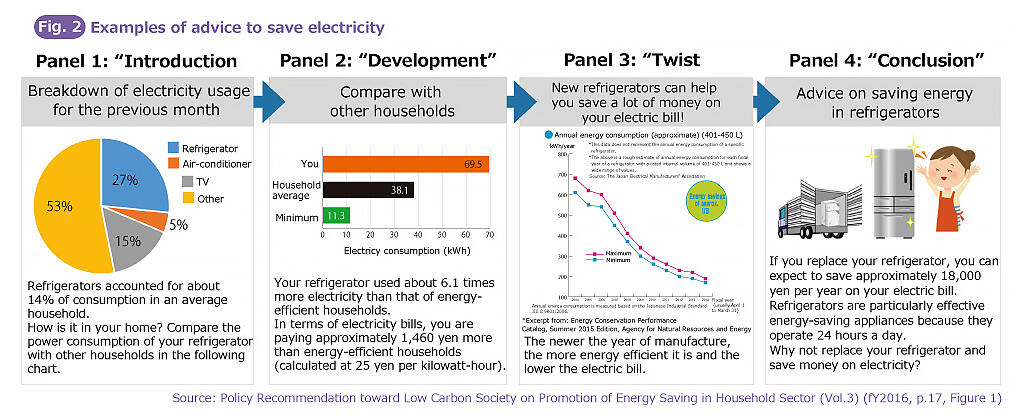
Energy measures for your entire home: Zero utility costs are not a dream
Iwata: You can reduce your CO2 emissions even more dramatically if you take energy measures not for a single appliance, but for your whole house. Zero utility bills aren't a dream if you turn your house into a small power plant.
Minagawa: You can produce electricity with solar panels. But with solar power, you can only produce electricity during the day when the weather is nice, right?
Iwata: That's right. It's true that solar panels can only produce electricity during the daytime, but unbalanced power can be managed efficiently by selling surplus power during the day to power companies or by using storage batteries. Furthermore, as I mentioned earlier, if you improve the insulation in your house and use a heat pump system for air conditioning and for hot water, you can achieve zero annual energy consumption. We call them "Net Zero Energy Houses," or ZEH, and if you search the web, you will find a lot of information about them.
Minagawa: This could create business opportunities for my company. I remember hearing about well-insulated houses and how common houses with good insulation are in Hokkaido, and that the interior of a house in winter is much more comfortable than in Tokyo.
Iwata: Yes. ZEHs not only have low CO2 emissions and low utility costs but are also comfortable.
Minagawa: I have heard many good things. Combined with the Nudge method you mentioned before, it would be nice if energy-saving appliances and ZEHs could be promoted more widely.
Iwata: However, in order to truly achieve zero CO2 emissions, there are some issues to be addressed, such as improving the ratio of renewable energy from external power supply sources and improving the environment for selling electricity.
Minagawa: It's not a simple task, which is why it will be a great achievement if it can be done. Do you have any good ideas related to power generation?
Iwata: One technology that is attracting attention is methane fermentation technology, which produces gaseous fuel from waste biomass. Hiroshi Iwasaki, a researcher at LCS, knows a lot about it, so please ask him.
Minagawa: Thank you for introducing the person for the next instalment. First, let me digest the report you showed us today. Thank you very much for your valuable talk today.
*This is a fictional narrative based on an interview.
